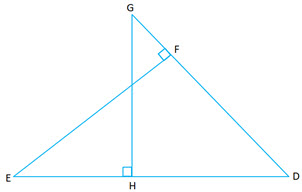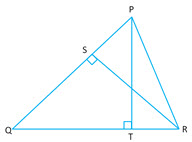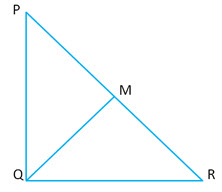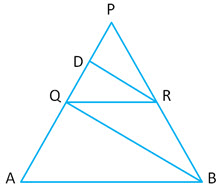Question 1: State True or False:
(i) Two similar polygons are necessarily congruent – False
(ii) Two congruent polygons are necessarily similar – True
(iii) All equiangular triangles are similar – True
(iv) All isosceles triangles are similar – False
(v) Two isosceles right angles triangles are similar – True
(vi) Two isosceles triangles are similar if an angle of one is congruent to the corresponding angle of the other – True
(vii) The diagonals of the trapezium, divide each into proportional segments – True
Question 2: , where
are points on
respectively. Prove that
Also find the length of
Answer:
Question 3: ,
Find the length of the segments
Answer:
Question 4: is a point of side
of
such that
Prove that
Answer:
Question 5: In the given figure, are right angled at
respectively.
(i) Prove (ii) Find
[2012]
Answer:
Question 6: are points in sides
respectively of parallelogram
If diagonal
and segment
intersect at
; prove that:
Answer:
Question 7: are altitudes of
Prove that
Answer:
(Given, altitudes)
Question 8: is a rhombus,
are straight lines. Prove that
Answer:
Answer:
Question 10: and the bisector of
meets
at point
Prove that
Answer:
(
)
Question 11: Prove that:
Answer:
(iii) Adding (i) and (ii)
Question 12: Prove that
Answer:
Question 13:
Answer:
Question 14: In the figure, is a parallelogram with
is a point on
such that
produced meets
at
produced at
Find the lengths of
[1997]
Answer:
Question 15: In quadrilateral , Diagonal
intersect at point
such that:
Show that
is a parallelogram.
Answer:
.. … … … (i)
.. … … … (i)
Therefore from (i) and (ii)
Similarly
Also it is given that
Question 16: Prove that:
Answer:
.. … … … (i)
.. … … … (ii)
and
Question 17: Show that
Answer:
Also
(SAS postulate)
Adding
.. … … (i)
We k.. … … … (ii)
From (i) and
Question 18: In the given figure ;
(i) Name the three pairs of similar triangles
(ii) Find the lengths of
Answer:
, The three pairs of similar triangles are
Answer:
Using basic proportionality theorem
.. … … … (i)
.. … … … (ii)
From (i) and (ii) we get
Question 20: Through the mid point of the side
of a parallelogram
, the line
is drawn intersecting diagonal
produced
Prove that
Answer:
(as M is the midpoint of CD)
Question 21: In the figure given below, is a point on
such that
(i) Calculate the ratio , giving reasons for your answer.
, calculate length of
[1999]
Answer:
Also , applying basic proportionality theorem
Question 22: In the right angled is the altitude. Given that
, calculate the value of
[2000]
Answer:
Question 23: In the figure given below, median of the
meet at
Prove that:
Answer:
are medians
Applying converse of proportionality theorem
